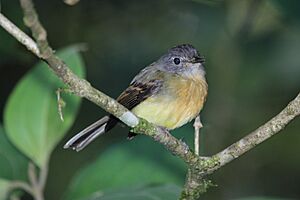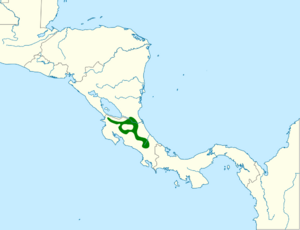Tawny-chested flycatcher facts for kids
Quick facts for kids Tawny-chested flycatcher |
|
|---|---|
 |
|
| Conservation status | |
| Scientific classification | |
| Genus: |
Aphanotriccus
|
| Species: |
capitalis
|
 |
|
The tawny-chested flycatcher (Aphanotriccus capitalis), also called Salvin's flycatcher, is a small songbird. It belongs to the tyrant flycatcher family. This bird lives in the lowlands and foothills of the Caribbean region. You can find it from eastern Nicaragua to northern Costa Rica. It usually lives in areas up to 1000 meters (about 3,280 feet) high.
Contents
What Does It Look Like?
The tawny-chested flycatcher is about 12 centimeters (5 inches) long. It weighs around 7 grams, which is about the same as two pennies. It looks a bit like a colorful Empidonax flycatcher.
Colors and Markings
This bird has a grey head and a white throat. It also has white "spectacles" around its eyes. Its upper body is olive-green. The wings are dark with two bright orange-yellow bars. The edges of its secondary feathers are also orange-yellow.
The chest of this bird is a pretty orange-yellow color. This color turns bright yellow on its belly. Male and female tawny-chested flycatchers look very similar. Sometimes, females might have a slight olive tint on their grey heads.
Where It Lives
This flycatcher likes to live in old, grown-up evergreen forests. It also lives in tall areas where plants have grown back after being cut down. You can often find it in thick plants along the edges of woodlands. It also likes areas near streams, in natural clearings, or even in cacao plantations.
Life and Habits
You will usually see the tawny-chested flycatcher alone or in pairs. It flies along a regular path looking for insects to eat. It especially likes beetles and ants. It picks these insects from the underside of leaves while flying.
Sounds and Behavior
This bird has a fast call that sounds like chee chee spt’t cheew. Sometimes, it will nervously fan and close its tail.
Reproduction
The female tawny-chested flycatcher builds the nest. She uses a natural hole in a tree or a hole made by a woodpecker. Nests can be up to 6 meters (about 20 feet) above the ground.
Scientists do not have a full description of their eggs yet. However, most tyrant flycatchers lay two eggs. The female bird sits on the eggs for about 15 to 16 days until they hatch.
Why This Bird Needs Help
The tawny-chested flycatcher is facing some challenges. People are cutting down forests for logging and to make room for banana plantations and cattle farms. This has led to a lot of forest being cleared. The remaining forests are broken up into smaller pieces. This is called forest fragmentation.
This bird does not like living in broken-up forests. Its home range is also quite small. Because of these reasons, scientists think its numbers are going down. More research is needed to understand this fully.
One thing that might help this bird is its nesting habit. It builds nests in cracks and holes. A type of bamboo called Guadua bamboo is often planted to support banana trees on plantations. This bamboo might provide new nesting spots for the flycatcher.


